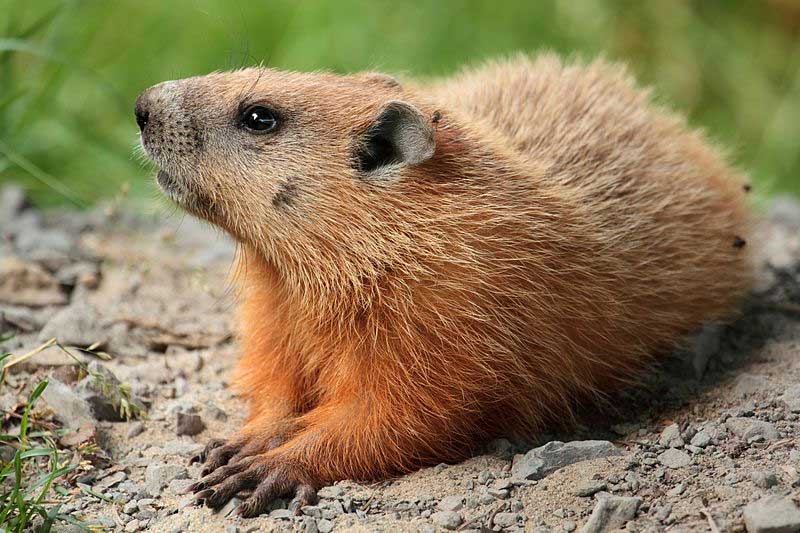About that groundhog (and his day)

The groundhog, a.k.a the woodchuck, or marmot, or whistle-pig, or weatherman? Photo: Cephas, Creative Commons, some rights reserved
Researchers are still puzzling over the age-old question, “How much wood could a woodchuck chuck if a woodchuck could chuck wood,” but I may have a solution. Re-brand the woodchuck.
Like the words skunk and moose, woodchuck is a Native American term, Algonquin in this case. I don’t know its English translation, but I’d guess it means “fat fur-ball that can inhale one’s garden faster than one can say ‘Punxsutawney Phil.’” Or something like that.
Too bad the name woodchuck implies they’re employed in the forest-products industry. Woodchucks haven’t the teeth for chewing wood, nor do they have much use for wood in their burrows. (We can only assume their dens aren’t paneled.)
Much as I respect the origin of ‘woodchuck,’ I’m in favor of sticking to one of its other names, groundhog, which is more descriptive. Not only do these rotund herbivores reside underground, they’re such gluttons that I’m pretty sure even swine call them hogs. Tellingly, another common name is ‘whistle-pig,’ referring both to groundhogs’ warning call and their voracious appetite.
Mature groundhogs in wild areas typically measure 15-25” long and weigh 5-9 lbs. With access to lush gardens or tasty alfalfa, though, they can grow to 30” long and weigh as much as 30 lbs. Now that’s a ground hog. Needless to say, vacuuming up fields and gardens has given them a bad name in some circles.
Native to most of North America from southern Alaska to Georgia, groundhogs are a type of rodent called a marmot. They’re related to other marmots and to ground squirrels out west, but in the northeast they have no close kin. Given what a marmot can eat, that’s a mercy.
They may be gluttons, but they’re not lazy. Groundhogs dig extensive burrows up to 5’ deep and 40’ long, each having two to five entrances. Supposedly, the average groundhog moves 35 cubic feet of soil excavating its burrow. (I’d like to know who measures these things.)
Alfalfa rustling is bad enough, but this hole-digging hobby really riles farmers. Groundhog holes and soil piles can injure livestock, weaken foundations and damage equipment. Many a farmer trying to mow hay has cursed the groundhog when the haybine ‘found’ a soil pile. Hard to appreciate groundhogs’ cuteness while you replace cutterbar knives for the tenth time.
True hibernators, groundhogs usually den up in October, their winter body temperature dropping to 50F and their heart slowing to a few beats per minute. Groundhogs might emerge in February in Pennsylvania, but up north you won’t find one blearily sniffing around for a mate that early. I’ve seen a burrow entrance in March with a halo of dirt scattered on the snow from where the critter had recently burst out, a squint-eyed dust mop looking for love.
The notion that sun on February 2 means a late spring began in ancient Europe. That date marks the pagan festival of Imbolc, halfway between winter solstice and spring equinox. Imbolc was supplanted by Candelmas as Christianity spread, but both traditions reference the “sunny equals more winter; cloudy equals spring” idea.
Mostly because Europe lacked groundhogs, Groundhog Day was invented in the New World, first popping up among Pennsylvania Germans in the mid-1800s. Though Punxsutawney Phil was the original prognosticating marmot, others like Wiarton Willie in Wiarton, Ontario; Jimmy the Groundhog in Sun Prairie, WI and General Beauregard Lee of Lilburn, GA followed.
We know how much ground a groundhog can hog: a lot, especially if beans and peas are growing on it. I say we pull those researchers off the wood-chucking quantification project and have them find how to make Groundhog Day overcast so we can get a break from the deep-freeze.
Paul Hetzler is a horticulture and natural resources educator with Cornell Cooperative Extension of St. Lawrence County
Tags: wildlife








You don’t see too many groundhogs/woodchucks in the Adirondacks but having lived in farm country, I know them quite well.
When we lived in Schoharie County, we were surrounded by a dairy farm. At the time, I had a malumute who loved catching and eating woodchucks. The farmer was happy with how my dog had a knack for catching these fat animals because cows sometimes stepped in one of their holes and broke a leg.
The only problem I had was needing to clean the entrails off the lawn after the dog ate everything but them.
Of course, here in the Adirondacks, they are never able to predict the end of winter because we always have six weeks or more of winter. Sometimes a lot more.
Good story Mr. Klein. Thanks. Where I grew up they were all over the place. My older brother would drive around and we would shoot them with a .22 and always hang them over the farmers fence. Lots of kids did and no farmer ever complained. Hey, sounds dumb, but if your older brother does it, it must be cool. And they are a problem for farmers.